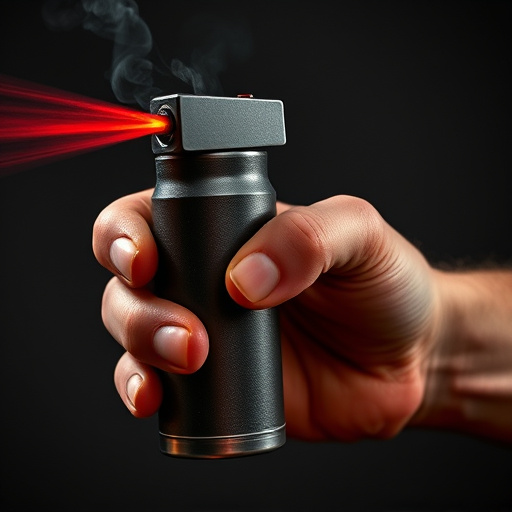Non-lethal pepper spray defense is a powerful tool for personal safety, leveraging capsaicin from chili peppers to temporarily incapacitate assailants by causing intense irritation and vision impairment. Widely adopted by law enforcement and civilians alike, its effectiveness, ease of use, and minimal harm make it a popular choice for self-defense. However, understanding legalities and safety precautions, including proper training and handling techniques, is crucial to ensure responsible and safe deployment without endangering bystanders or users.
In today’s world, personal safety is paramount. One effective tool in a individual’s defense arsenal is non-lethal pepper spray, a powerful chemical irritant designed to temporarily incapacitate assailants without causing permanent harm. This article delves into the science behind pepper spray, its role in personal protection devices, key components and formulations, real-world applications, and essential legal considerations and safety precautions. Understanding these aspects empowers individuals to make informed decisions about using non-lethal pepper spray as a vital defense mechanism.
- Understanding Chemical Irritants: The Science Behind Pepper Spray
- Non-Lethal Pepper Spray: Its Role in Personal Protection Devices
- Components and Formulations: What Makes Pepper Spray Effective?
- Applications and Use Cases: When and How to Deploy Pepper Spray
- Legal Considerations and Safety Precautions for Using Chemical Irritants
Understanding Chemical Irritants: The Science Behind Pepper Spray
Understanding Chemical Irritants: The Science Behind Pepper Spray
Chemical irritants, particularly non-lethal pepper spray, have become essential tools for personal protection. These innovative devices harness the power of capsaicin, the active ingredient found in chili peppers, to disrupt an assailant’s senses and provide a crucial window of escape. When deployed, pepper spray creates a burning sensation by binding to pain receptors in the eyes and nose, leading to temporary blindness and congestion. This temporary incapacitation allows individuals to defend themselves or seek help, making it an effective component in personal safety strategies.
Non-lethal pepper spray defense is not merely about causing physical discomfort; it’s a science that leverages natural compounds to deter aggression without causing permanent harm. The precise concentration of capsaicin in these sprays ensures their effectiveness while minimizing potential adverse effects on bystanders or the user. This balance makes pepper spray a popular choice for law enforcement, security personnel, and individuals seeking proactive measures to safeguard their well-being.
Non-Lethal Pepper Spray: Its Role in Personal Protection Devices
Non-lethal pepper spray is a powerful tool in personal protection devices, offering an effective yet non-fatal response to potential threats. This type of spray inhibits an attacker’s vision and breathing, providing the user with precious time to escape or summon help. In many situations, it acts as a crucial deterrent, allowing individuals to defend themselves against agressors without causing permanent harm.
The use of non-lethal pepper spray defense has gained significant popularity due to its ease of use and high effectiveness. It’s widely used by law enforcement, security personnel, and civilians alike for self-defense purposes. Its non-fatal nature makes it a preferred choice in situations where de-escalation is key, while still ensuring the safety and well-being of the user.
Components and Formulations: What Makes Pepper Spray Effective?
Pepper spray, a non-lethal defense option, is an effective chemical irritant designed to temporarily disable and disrupt an assailant’s vision and movement. Its primary active ingredient is capsaicin, the compound responsible for the heat sensation in chili peppers. This compound, when sprayed into the eyes and face, causes intense irritation, leading to tears, pain, and temporary blindness.
The formulation of pepper spray involves a precise balance of capsaicin and other chemicals like oleoresin capsicum (OC). OC acts as a carrier, enhancing the delivery of capsaicin and extending its duration. The solution is typically suspended in a water-based mixture to ensure easy spraying and rapid dissipation, minimizing environmental impact. This combination creates a powerful non-lethal pepper spray defense, providing individuals with an effective means to deter and escape potential threats.
Applications and Use Cases: When and How to Deploy Pepper Spray
Pepper spray, a non-lethal chemical irritant, has become an indispensable personal protection device in various scenarios. Its primary application lies in law enforcement and self-defense situations where a quick, effective, and temporary incapacitation of an aggressor is required. When deployed, pepper spray creates a burning sensation and temporary blindness, allowing users to escape or subdue their assailants.
Use cases for non-lethal pepper spray defense span from personal safety during late-night walks or in high-risk areas to crowd control at protests and public events. It’s crucial to understand the right moment to employ this device—when facing an imminent threat or attack, as opposed to preventive measures. Proper training on its use is essential to ensure maximum effectiveness and minimal risk to bystanders.
Legal Considerations and Safety Precautions for Using Chemical Irritants
When utilizing chemical irritants, such as non-lethal pepper spray for personal defense, it’s paramount to understand and adhere to legal considerations and safety precautions. Each jurisdiction has specific laws governing the possession, use, and application of such devices, so users must be well-versed in their local regulations. Unauthorized carrying or deployment could result in serious legal repercussions.
Safety precautions are equally critical. Chemical irritants can cause significant discomfort, blindness, and respiratory distress if not handled properly. Users should receive adequate training on safe handling, storage, and application techniques to minimize risks. Wearing protective gear and ensuring proper ventilation during use is also essential to prevent accidental exposure and potential harm to oneself or others.
In conclusion, non-lethal pepper spray defense has established itself as a valuable tool for personal protection devices due to its unique chemical irritant properties. Understanding the science behind pepper spray, its components, and applications is crucial for effective deployment and safety precautions. As with any chemical irritant, legal considerations must be taken into account to ensure responsible use. By staying informed and adhering to guidelines, individuals can leverage non-lethal pepper spray as a reliable means of self-defense in various situations.
